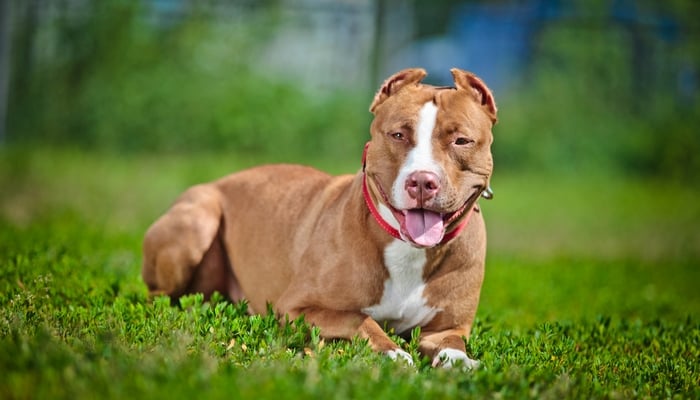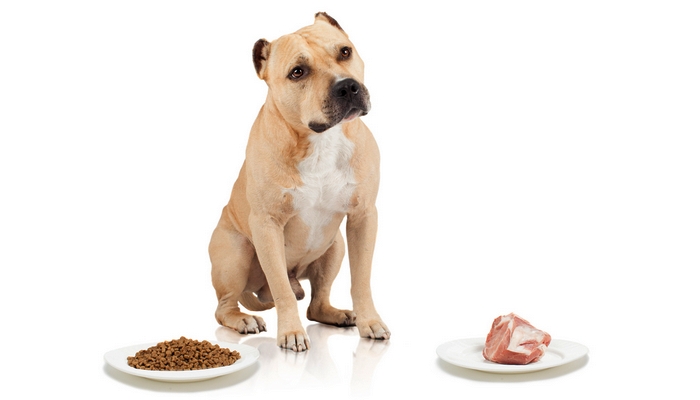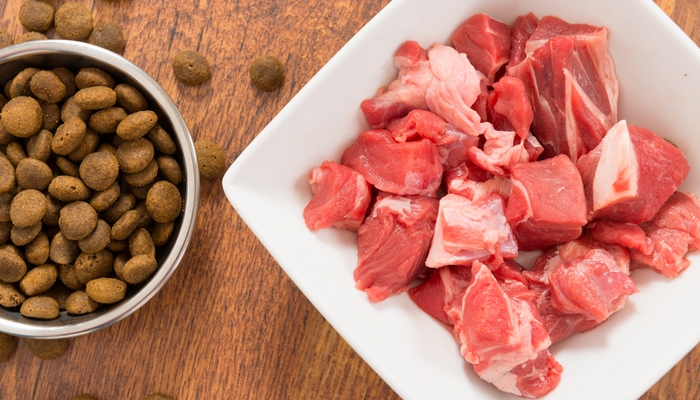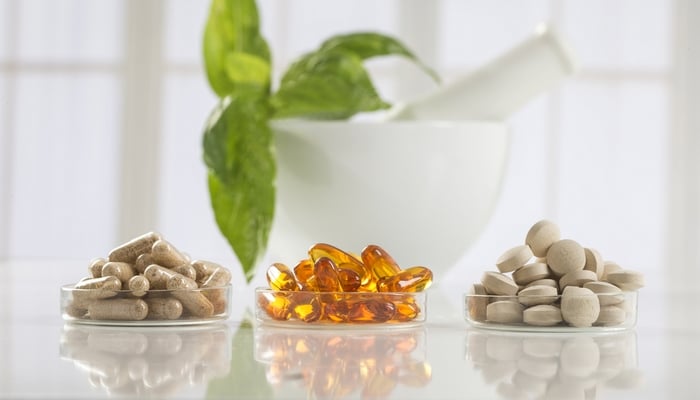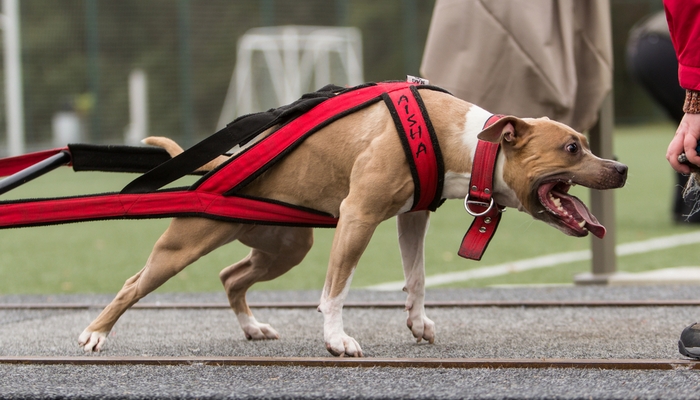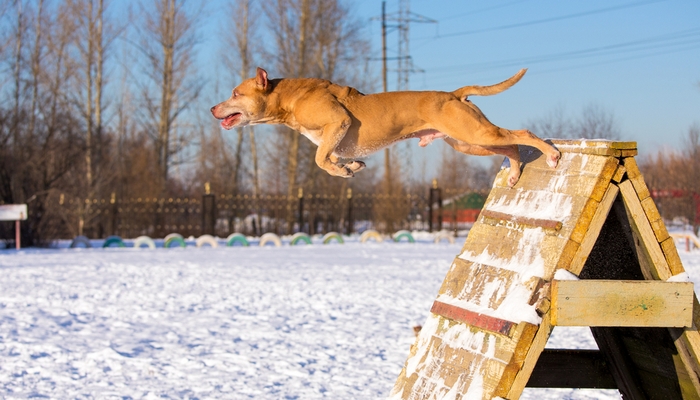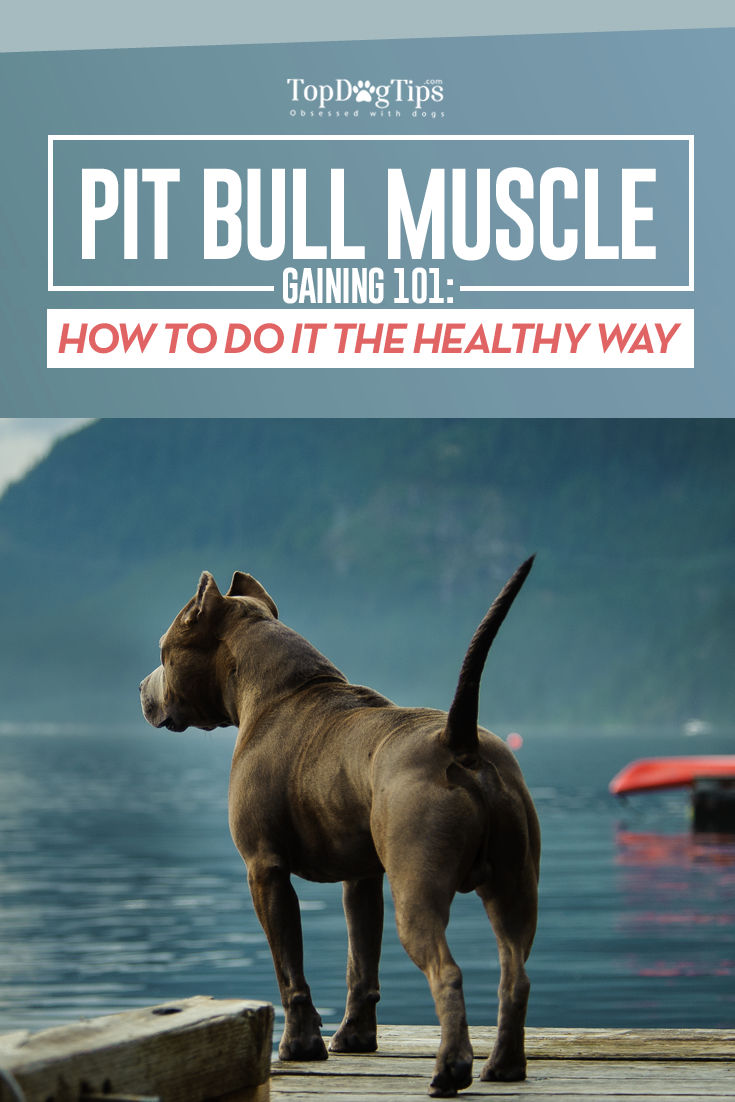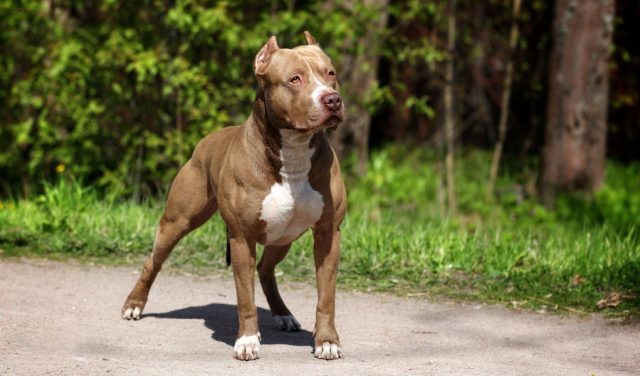
The concept of bulking up a Pit Bull is often associated with a negative connotation.
However, the truth is that there are other reasons for beefing up this naturally muscular breed.
The American Pit Bull Terrier is a naturally stocky dog with a well-defined muscular structure.
This is the appearance that defines this very athletic canine breed.
For a Pit Bull to be representative of his breed, many pet parents wish for a degree of bulkiness and muscular definition.
But just a word of caution.
This “healthy bulk” that represents the Pit Bull breed should not be confused with the “excessive bulking” associated with dog fighting or any other illegal or harmful dog practices.
It should go without saying that the type of extreme bulking up associated with dog fighting is detrimental to the dog's health and can lead to many crippling side effects.
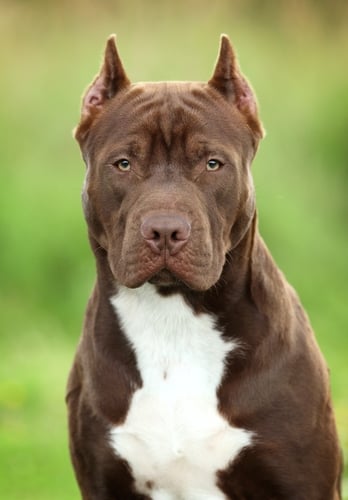 Additionally, it is our responsibility here at Top Dog Tips to remind you that it is a felony to be associated with dog fighting in all 50 U.S. states, the District of Columbia, Guam, Puerto Rico, and the U.S. Virgin Islands. It is also a top-tier felony to be involved in any case of animal cruelty in any state within the United States.
Additionally, it is our responsibility here at Top Dog Tips to remind you that it is a felony to be associated with dog fighting in all 50 U.S. states, the District of Columbia, Guam, Puerto Rico, and the U.S. Virgin Islands. It is also a top-tier felony to be involved in any case of animal cruelty in any state within the United States.
Please use all of the information contained within this article responsibly and sensibly.
As an educated dog owner, you should know the limits of your dog and know what makes a HEALTHY Pit Bull physique.
Most of all, be a responsible bully breed owner.
Now we got that out of the way, let's discuss in the following sections how you can bulk up your pit bull in a healthy way.
ALSO SEE: 8 Best Weight Gain Supplements for Dogs
Pit Bull Muscle Gaining 101
How to Bulk Up a Pit Bull in a Healthy Way
Basic Guidelines in Bulking Up a Pit Bull
One of the reasons why people bulk up their Pit Bulls is for them to better represent the breed.
But before we get into the details, let’s touch on a few guidelines that will help facilitate a healthy and successful Pit Bull bulking process in the long term.
- NEVER try to bulk up a dog under 18 months of age. During the first 18 months, a dog is still growing. Overworking their growing bones or adding too much weight to a developing frame can be crippling.
- NEVER use huge collars, weighted vests, oversized chains, or other unprofessional equipment to bulk up a Pit Bull. These are not strength-building tools; they are dog-fighting tools.
- ALWAYS use your dog’s natural strength to bulk him up and condition him athletically. Do not overstress your dog's body or nervous system. Give serious attention to all the training and nutrition plans.
- ALWAYS use positive approaches to training and create an athletically built dog that enjoys what he is doing rather than a beaten down dog that suffers and does things out of fear.
Remember, bulking up a pit bull should be about a healthy example of the breed.
A healthy dog is a happy dog, and both of you will benefit far more from doing things the right way.
Now, what's the best thing you can do if you're interested in learning all about how to bulk up a Pit Bull?
First, you NEED to speak to your veterinarian.
You should never change a dog's diet without consulting with a vet.
They know your pet's health history and are the best resource you have when deciding how to get your Pit Bull to gain muscle.
Looking for specific dog food brands to help bulk up your bully effectively?
We've published a list of top best dog foods for pit bulls to gain muscle which should stir you in the right direction.
RELATED: Staffordshire Bull Terrier Breed Profile
Proper Diet for Pit Bull's Muscle Gain
The approach to creating a muscular and athletically adept Pit Bull is two-pronged, much the same as it is for the human athlete.
The first prong is your bully's diet.
A well-balanced diet is important for any dog, but for a dog that is athletically inclined, it is even more important.
Canine athletes eat differently, and this needs to be monitored.
Your dog’s diet should provide the basic nutrition needed by his body, but it should also provide the additional nutrients needed to repair muscle fibers and build new muscle.
Selecting the right diet for your dog is definitely something that should be discussed with your veterinarian or a canine nutritionist before you make any changes yourself.
Good Quality Dog Food
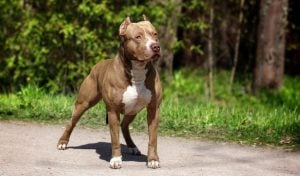 The first step in a healthy diet for an athletically built dog is to invest in good quality dog food.
The first step in a healthy diet for an athletically built dog is to invest in good quality dog food.
Just as a human athlete will not bulk up by eating junk food, a dog cannot bulk up by eating food that is full of fillers and other “junk” ingredients and is low in protein.
So, where do you start in your search for high-quality dog food for pit bull muscle gain?
Learn how to read dog food ingredients labels first.
Look for named meat protein sources like “beef”, “buffalo”, “lamb,” or “chicken” and avoid foods that are filled with artificial ingredients like food dyes, unnamed meat sources like by-products or unnecessary ingredients like “corn gluten meal”.
The aim is to get dog food that is as efficient as possible by cutting down the ingredients list to whole foods that all provide nutrition.
Organic dog food brands are usually a good point to start, but there are some other healthy dog foods that may fit your Pit Bull's diet well and provide him with all the nutrition for regular exercise and training.
Speaking of nutrition, in addition to finding high-quality ingredients, you must also focus on finding dog foods with macronutrients that cater specifically to an athletic lifestyle.
Look for dog food brands that are rich in protein and fat; carbs don't need to be avoided.
Protein will help to build muscle and repair muscle fibers damaged during exercise.
Fat will help to maintain body weight despite physical exertion. It is important to ensure that fats included in food are healthy fats, however, because Pit Bulls can also become obese.
RELATED: 16 Best Tips from Four Famous Vets on Dog Nutrition and Feeding
Importance of macronutrients and their ratios
Striking a good balance in the diet of the athletic dog is very important.
Without enough protein, your Pit Bull isn’t going to gain any muscle and will recover much slower from conditioning and heavy exercises.
On the other hand, vets also say that too much protein may cause your dog to suffer from damage to his kidneys.
Too much fat and your dog will become obese, not enough fat and he will begin to lose weight due to the insufficient caloric intake.
So, what kind of balance are you looking for in dog food that is optimized for an athletic or working dog?
Ideally, the canine athlete requires a diet that is around 30% protein and 25% fat.
Adding supplements for dogs like omega fatty acids, glucosamine, and chondroitin may also be extremely beneficial and improve your dog's performance.
How often and how much should you be feeding this food to your bully? It's a tricky question, and that's why you must consult with a vet beforehand.
The American Pit Bull Terrier’s weight ranges so drastically that there is no definitive answer to how much you should feed him.
The best place to begin is to follow the recommended feeding instructions on dog food labels, specifically on those that have been developed for a working or athletic dog.
Base your feeding amounts on your dog’s current weight.
If you notice that he is losing weight or still seems to be hungry after eating, increase the amount of dog food per serving just so slightly.
Just be sure not to overfeed your canine.
FURTHER READING: The Low Down On the Paleo Diet for Dogs
Supplements for Pit Bulls
There are many supplements on the market that target Pit Bull owners in particular.
The truth about these supplements, however, is that they contain the same ingredients as multivitamins.
The problem with that is that when you feed your dog a healthy and high-quality diet, he will not need to take a multivitamin.
If, after consulting with your vet, your vet recommends multivitamin support, consider a multivitamin rather than a more expensive formula with the same ingredients.
There are some supplements that your bully can benefit from when bulking up, including:
 A high-quality joint supplement – the levels of glucosamine, chondroitin, and omega fatty acids in dog food are often not high enough for the needs of an athletic dog.
A high-quality joint supplement – the levels of glucosamine, chondroitin, and omega fatty acids in dog food are often not high enough for the needs of an athletic dog.
To offer your Pit Bull complete joint support, consider a vet-approved joint supplement.
The more you train your Pitbull, the more stress his joints receive, so it's vital to provide nutritional support to avoid any complications and especially arthritis.
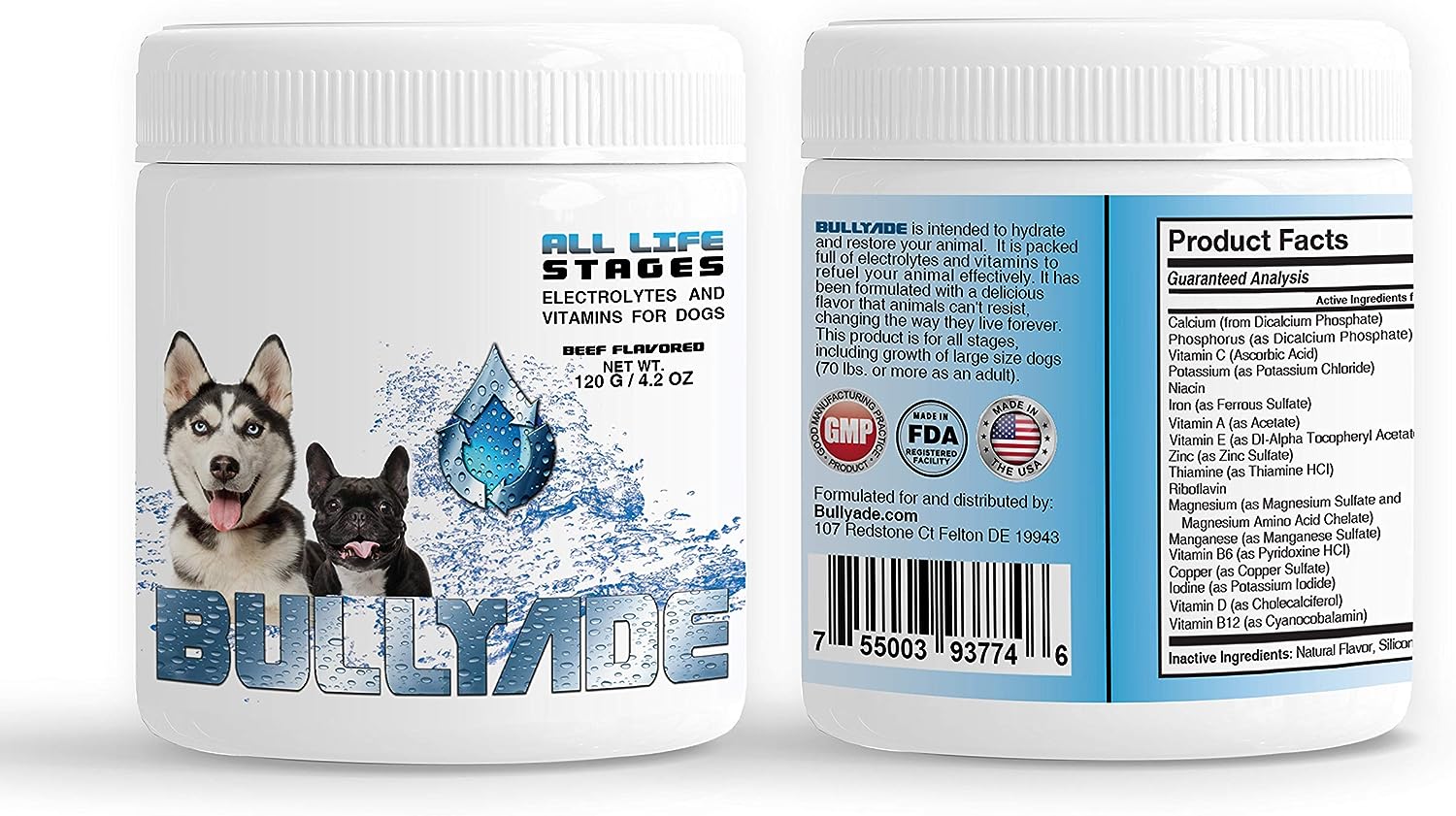
Electrolyte formula – Depending upon the time of year, the exercise routine your dog is taking part in, and his overall health, an electrolyte formula is always good to keep on hand.
This should not be a daily necessity, but it is perfect for rehydration after exertion and helping to promote recovery time after training.
There are specific dog food brands for pit bulls that are formulated for their lifestyle, heavy-duty training, and muscle gain.
Bully Max 30/20 High Performance dog food is one of the better-known brands, but any other performance dog food would work just as well, and you don't necessarily need to use this specific formula.
Additionally, there are also protein powders for Pit Bulls that are said to improve their athletic performance and help them gain muscle.
Muscle Bully Protein Supplement is currently the most popular option. However, many argue whether this is necessary at all since many dogs can get all these nutrients from regular dog food.
RELATED: 8 Superb Pet Supplements for Your Dog
Exercise for Pit Bull Muscle Gaining
In addition to your Pit Bull's healthy and balanced diet, exercise is a major factor in bulking up your bully.
As mentioned previously, it is important not to begin any serious bulking up or conditioning with a Pit Bull under the age of 18 months.
During these early years, the muscles and bones of the dog are still growing and forming. Strain could cause deformation or damage that is irreversible.
Strength Training
Building muscle in a Pit Bull should be done using the dog’s natural strength.
A great activity that does this is weight pulling or cart pulling.
This type of activity should begin with using only light weights and professional harnesses and under the supervision of a professional trainer.
This is important because it ensures that your dog remains healthy while he trains.
Without the supervision of a knowledgeable trainer, you can quite easily overtax your dog and cause him injury.
If you want to bulk up your dog, shouldn’t you be using heavy weights?
NO! You wouldn’t go straight to the gym and start lifting with a 500 lb. barbell, would you? No, because you need to build up your strength first.
The same principle applies when it comes to strength training your dog.
You need to begin slow with light weights, and over time, increase the weight your dog pulls gradually.
Always ensure that it is not so much that it overtaxes your Pit Bull.
Strength training is a time-consuming process. Just like a human athlete, it will take your Fido years to accomplish the strength of an athlete.
RELATED: Dog Agility Competitions – How to Start, Science on Risks & Injuries
The Importance of Stamina
Stamina is an important factor in creating a sculpted Pit Bull.
While strength training will help to build muscle, it will only go so far if your dog is unable to keep up with his training routine.
To build on your dog’s strength and musculature, you also need to work on his stamina.
To do this, you want to gradually increase the distance that your dog is pulling his light weights.
As you increase the distance that your dog covers, you are increasing his ability to keep up physical exertion.
But why is stamina important?
Why can’t you just train your dog to be a “strong man” rather than a tri-athlete?
Because working on strength training and not working on stamina simultaneously will not build high-quality muscle tone, nor will it develop strength.
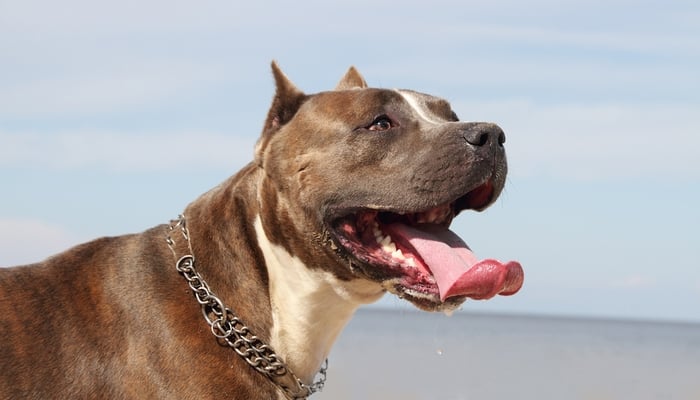 Stamina is what allows an athlete to keep up training over time periods long enough to develop and maintain muscle.
Stamina is what allows an athlete to keep up training over time periods long enough to develop and maintain muscle.
Look at it this way.
If you go to the gym and you do two reps with a dumbbell every day and increase the dumbbell weight by 10lbs, are you going to build muscle?
No, you are going to injure yourself.
Now, if you go to the gym every day and do two reps with a dumbbell one day, four reps with the same dumbbell the second day, and gradually increase your reps for two weeks, and then increase your dumbbell weight and go back to two reps, you are going to slowly build strength and gain muscle.
You are not going to hurt yourself.
The same principle applies to training your Pit Bull.
To bulk up your Bully, you must focus on growing his stamina as well as his strength.
In addition to weight pulling or sled pulling, other activities that can help to bulk up your Pit Bull include:
- Walking that gradually becomes running
- Swimming – this is a great way to provide low-impact exercise that increases stamina
- Walking through boggy land – this provides resistance while your dog walks and helps to build muscle
A Word of Caution
When bulking up your Pit Bull, always keep your dog’s health and happiness in mind. This means taking every other day to allow your dog to rest. It means always training under the supervision of an educated trainer and a veterinarian. It means listening to your dog. Don’t let your desire to bulk up your Pit Bull override his health.
READ NEXT: 10 Best Dogs To Run With & Breeds That Love To Run
Disclosure: We may earn affiliate commissions at no cost to you from the links on this page. This did not affect our assessment of products. Read more here and find full disclosure here.


